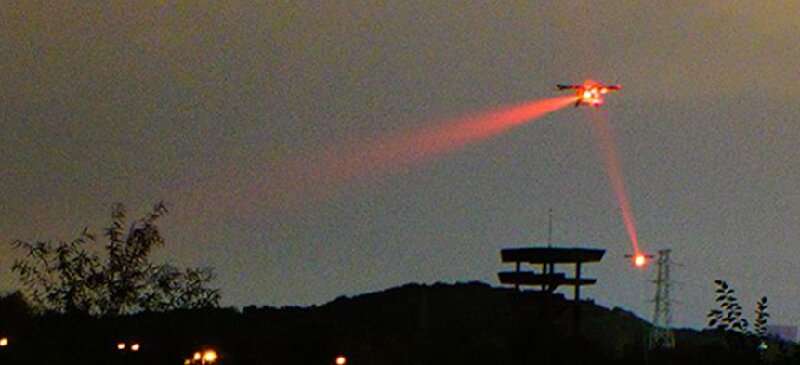Target acquisition. The beams from one drone are visible over the testing area. Credit: X.-H. Tian, H.-Y. Liu, & Z. Xie/Nanjing Univ.
A team of researchers affiliated with several institutions in China has used drones to create a prototype of a small airborne quantum network. In their paper published in the journal Physical Review Letters, the researchers describe sending entangled particles from one drone to another and from a drone to the ground.
Computer scientists, physicists and engineers have been working over the last several years toward building a usable quantum network—doing so would involve sending entangled particles between users and the result would be the most secure network ever made. As part of that effort, researchers have sent entangled particles over fiber cables, between towers and even from satellites to the ground. In this new effort, the researchers have added a new element—drones.
To build a long-range quantum network, satellites appear to be the ideal solution. But for smaller networks, such as for communications between users in the same city, another option is needed. While towers can be of some use, they are subject to weather and blockage, intentional or otherwise. To get around this problem, the researchers used drones to carry the signals.
The work involved building a small laser-generating device and affixing it to one of the drones. As it fired, photons were split in two, creating entangled pairs. One of the paired photons was directed toward another drone while the other was directed to a ground station. The drone that received the entangled photon served only as a relay—after refocusing, the photon was forwarded to a third drone, which then sent it to a second ground station. Motorized devices were used on the drones to ensure transmitters and received lined up properly for transmission of the entangled photons.
In the prototype, the photons were sent just one kilometer, but the researchers suggest that moving the drones higher would allow for transmission over distances up to 300 kilometers. They suggest the technology could also be adapted to include moving vehicles on the ground. They further note both the drones and the ground stations could also be connected to a network that included satellites. And they also point out their work was the first to send entangled particles between two moving devices.
More information: Hua-Ying Liu et al. Optical-Relayed Entanglement Distribution Using Drones as Mobile Nodes, Physical Review Letters (2021). DOI: 10.1103/PhysRevLett.126.020503
Journal information: Physical Review Letters
© 2021 Science X Network
























